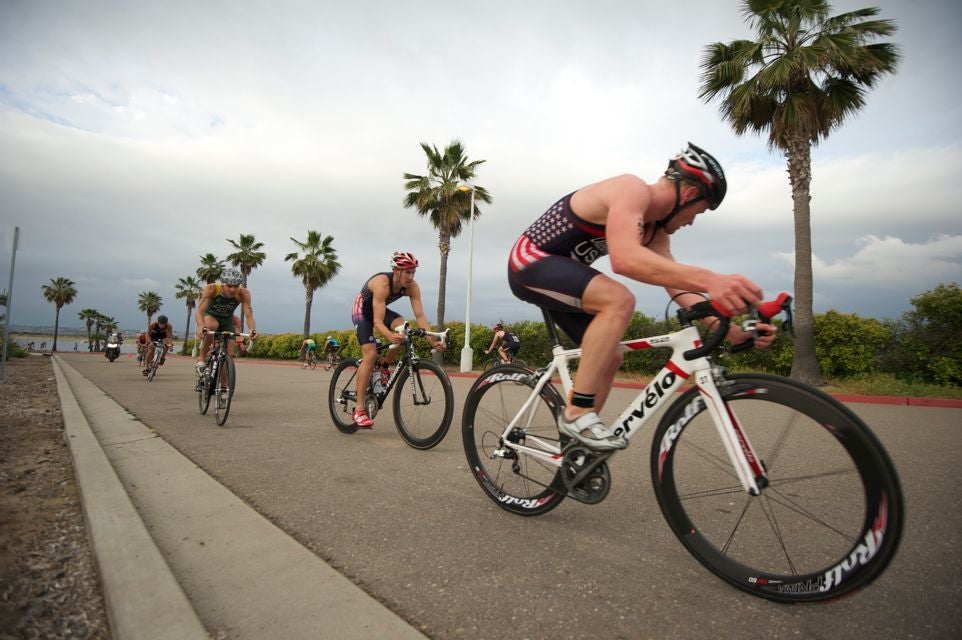Why The Super Sprint Matters

Americans Joe Maloy and Eric Lagerstrom. Photo: Aaron Hersh
USAT has high hopes for intense, compact race format.
The April 24 Fearless Pro triathlon was a night of high-intensity speed featuring top ITU athletes going head-to-head in a super sprint format in San Diego’s Mission Bay. But beyond the sheer excitement and unique draft-legal distance—375-meter swim, 6K bike and 1.5K run, twice through—the event could be a very important piece of U.S. triathlon’s future.
Andy Schmitz, USA Triathlon’s High Performance General Manager, says this type of racing will be integral to the sport for a few reasons, particularly skill development. With a five-loop, technical bike course, the race has a criterium feel that takes confident handling skills to tackle. He also believes the “grand prix” style is perfect for developing strong junior athletes who may not have the volume capabilities for an Olympic-distance event. Plus, because the mixed relay is being considered for the 2016 Olympics (which would entail a team of four all racing a swim-bike-run sprint), USAT is eager to breed potential racers for future teams.
“From our standpoint, we want to see our U.S. athletes here to prove that they belong on our team,” Schmitz says. “Our intention is to use this race format as a talent ID and a talent confirmation, really, for our U.S. team to select athletes for the mixed team relay.”
American Sarah Groff, who won Wednesday’s women’s race, thinks the events could help identify top talent that might not stand out at a typical ITU race. “The athletes who are good at this might not be identified in the Olympic-distance racing because this is pretty anaerobic, really technical kind of stuff, where you might bypass somebody who could just really shine at this distance,” she says.
PHOTOS: Aaron Royle Beats Out Olympians At Fearless Pro
Other countries regularly hold races of this nature, and in the late ‘90s, some of the sport’s most legendary athletes (Greg Welch, Craig Alexander, Chris McCormack, Greg Bennett) were brought up through the “grand prix” style in Australia. Proof of that carry-through may be in yesterday’s men’s winner, Australian U23 world champion Aaron Royle, who has experience racing this style back home.
“The Australians love this sort of thing—it’s part of their development, where their teenagers are thrown into this and they become much better technical athletes and become so much better about race tactics,” says Groff. “If we get more of this going, I think we’d really upscale our developing athletes, far more than if we have them doing Olympic-distance racing.”
Wednesday’s race, directed by Lars Finanger, was only publicly announced six weeks prior, and it served as a test run for future super sprint events. Organizers wanted to take advantage of having world-class talent in town for the April 19–20 ITU WTS event, so they slated the race for a weekday to catch athletes before they left town the following weekend. It worked, as fields included Olympians such as London bronze medalist Erin Densham, Andrea Hewitt, Gwen Jorgensen, Laurent Vidal and Ivan Vasiliev. After a request for proposal process, USAT subsidized the prize purse of $20,000. They hope to grow draft-legal races and super sprints in 2014 and beyond.
Outside of identifying Olympian potential, USAT sees it as a huge opportunity to attract new triathlon fans who may not have the attention span to watch an Olympic-distance race.
“You stand in one place and see the entire race unfold, and I think that can attract both television and spectatorship,” Schmitz says. “I think it’s a well-packaged, well-produced, spectator-friendly format that’s easy to follow. The Olympic distance is exciting, but you’re not going to get uneducated triathlon consumers to set aside two hours of their day to watch it. If an athlete watches this, they’ll be blown away by the speed, agility and quickness of these athletes.”
USAT CEO Rob Urbach agrees that the super sprint has long-term benefits for the exposure of the sport. “These events are really easy to televise and make for compelling, fast-action content,” he says. “In some respects, it will hopefully draw in someone who is channel surfing and has never seen a triathlon before, and will see it and think, ‘wow, that’s exciting—I thought triathlon was this all-day endurance event.’ It could really drive sponsorship and more exposure for the sport.”
Future events are already planned for September in Las Vegas (around the Interbike trade show), which will be televised on Universal Sports, and another one the last week in October following the Life Time Fitness Oceanside Tri in San Diego.
PHOTOS: Sarah Groff Impresses At Fearless Pro Triathlon
Join in the conversation about everything swim, bike and run. “Like” us on Facebook.